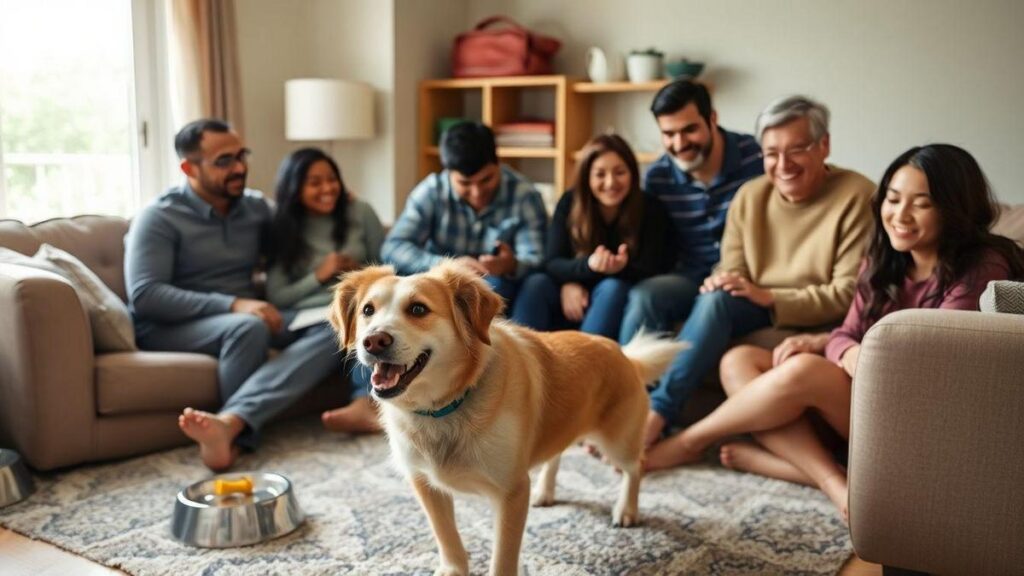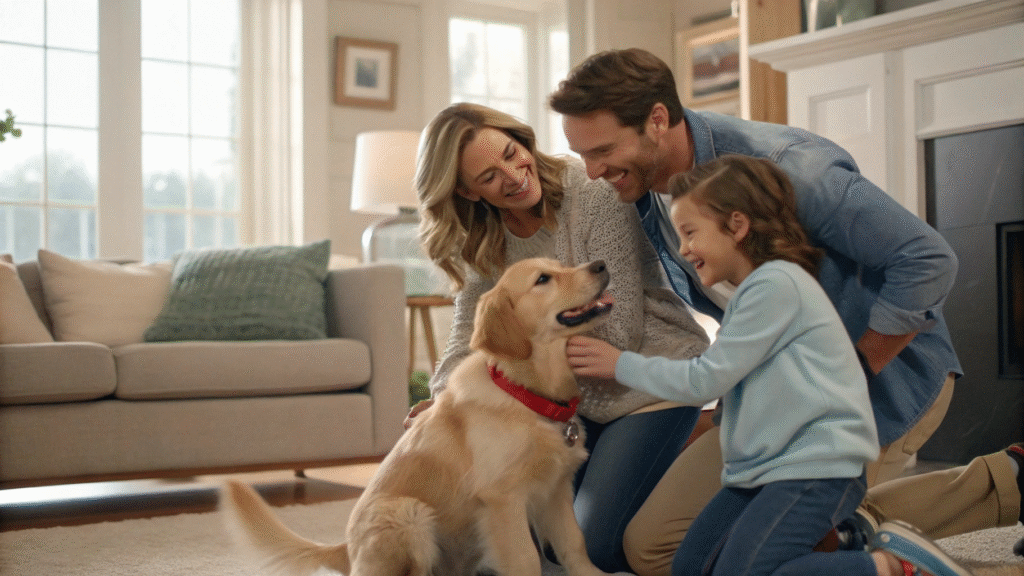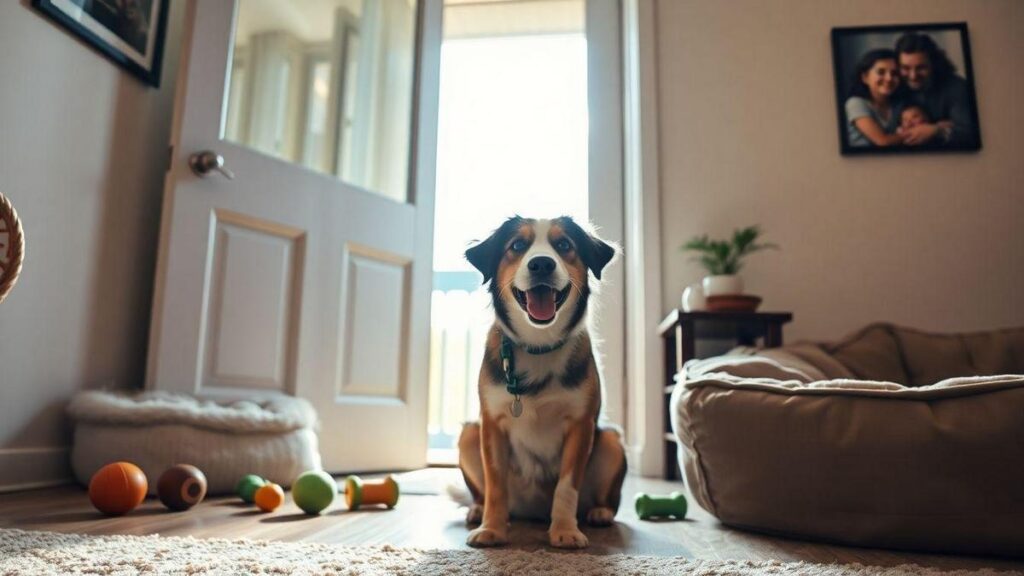When it comes to adopting a dog, knowing the Top 10 Mistakes to Avoid When Adopting Dogs can make all the difference. You want to give your new furry friend the best start in their new home, right? This article will help you understand the key things to watch out for, so you can enjoy a happy and healthy life together.
Let’s dive in and make sure you’re fully prepared for your new best buddy!
Important Points to Remember
- Don’t rush into getting a dog without planning.
- Choose the right breed for your lifestyle.
- Prepare your home for a new pet.
- Make sure you can commit to daily care.
- Avoid skipping training and socialization.

Summary
Understanding Dog Behavior: Why It’s Key Before Adoption
Alright, let’s dive into the world of dog behavior. Understanding how dogs think and act is crucial before you bring one home. It’s like knowing the rules of a game before you start playing. Dogs have their own ways of communicating and expressing emotions. They wag their tails when they’re happy, bark when they’re excited, and sometimes even growl when they’re feeling threatened.
So, why does this matter? If you don’t get what your dog is trying to say, it could lead to misunderstandings. Imagine adopting a dog that’s shy and nervous. If you don’t recognize those signs, you might overwhelm the poor pup. It’s all about building a bond, which starts with understanding.
Take time to observe different breeds and their typical behaviors. Some dogs are more energetic and playful, while others might be laid-back and just want to chill. If you’re active and love hiking, a high-energy dog might be a perfect fit. But if you prefer cozy nights on the couch, a more relaxed breed would suit you better.
Also, consider the dog’s past. A rescue dog might have some baggage from previous experiences. They may need extra patience and understanding. So, before you adopt, do your homework. Learn about the breed, the individual dog’s history, and what to expect. It’ll make your transition smoother and your new furry friend happier.
Choosing the Right Dog: Avoiding Common Mistakes
Choosing the right dog isn’t just about picking the cutest one at the shelter. It’s a big decision, and there are common mistakes people make. First off, don’t rush into it. Take your time. Visit shelters multiple times, interact with different dogs, and see who you click with.
One major pitfall is not considering your lifestyle. If you work long hours or travel a lot, a high-maintenance dog might not be the best choice. Think about your daily routine. Do you have time to walk, train, and play with a dog? If not, you might want to look into a breed that’s more independent.
Another mistake is ignoring the dog’s energy level. Some dogs need tons of exercise, while others are perfectly happy lounging around. If you adopt a dog that requires more activity than you can provide, it could lead to frustration for both of you.
And let’s not forget about size. A big dog in a small apartment can be tricky. They need space to move around and play. On the flip side, a tiny dog might not be the best fit for a family with young kids. It’s all about finding that balance.
Lastly, don’t overlook the importance of temperament. Some dogs are naturally more friendly and outgoing, while others may be shy or reserved. Spend time with the dog before making your decision. You want to ensure that their personality matches yours.
Top 10 Mistakes to Avoid When Adopting Dogs: The Basics
Okay, let’s break down the top 10 mistakes folks often make when adopting dogs. By knowing these, you can avoid common pitfalls and make your experience a lot smoother.
- Not doing enough research: Look into different breeds and their needs. Each breed has its quirks, so find one that fits your lifestyle. For more insights, check out Proven Methods to Find the Perfect Dog for Adoption.
- Rushing the process: Take your time. Don’t feel pressured to adopt on the spot. It’s a lifelong commitment, so make sure you’re ready.
- Ignoring breed characteristics: Some breeds are known for being more stubborn or energetic. Know what you’re getting into.
- Overlooking training needs: Every dog needs training, but some require more than others. Be prepared to invest time and effort into training. For tips on this, refer to 5 Essential Tips for Dog Adoption.
- Not considering long-term costs: Dogs come with expenses like food, vet visits, and grooming. Make sure you can handle the financial commitment. For budgeting advice, see First Year Pet Care Expenses.
- Choosing a dog based on looks: It’s easy to fall for a cute face, but personality matters more. Spend time with the dog before deciding.
- Failing to assess your living situation: Make sure your home is suitable for a dog. Do you have a yard? Is it dog-proof?
- Ignoring health issues: Some breeds are prone to certain health problems. Be aware of these and consider adopting a mixed breed for better health.
- Not preparing for the adjustment period: Dogs need time to adjust to their new home. Be patient and give them space to settle in.
- Forgetting about socialization: Dogs need to be socialized with people and other animals. Don’t neglect this crucial part of their development.
By keeping these mistakes in mind, you’ll be better prepared to welcome a new furry friend into your life.
Preparing for a New Dog: What You Need to Know
So, you’ve decided to adopt a dog. Awesome! But before you bring your new buddy home, there’s some prep work to do. First things first, make sure your home is dog-friendly. This means removing anything that could be harmful, like toxic plants or small objects they could swallow.
You’ll also want to gather some supplies. Here’s a quick list to get you started:
- Food and water bowls: Get sturdy ones that won’t tip over easily.
- Dog food: Talk to the shelter or vet about the best food for your new dog. For more on this, check out 5 Tips for Choosing the Best Dog Kibble.
- Collar and leash: Make sure they fit well and are comfortable.
- Dog bed: A cozy spot for your dog to relax is essential.
- Toys: Dogs love to play, so grab a few toys to keep them entertained.
- Grooming supplies: Depending on the breed, you might need brushes, nail clippers, or shampoo.
Next up, think about establishing a routine. Dogs thrive on consistency. Set up a feeding schedule, plan regular walks, and make time for play. This helps your dog feel secure and understand what to expect.
Also, consider where your dog will sleep. Some owners prefer to let their dogs sleep in bed with them, while others set up a crate or designated dog bed. Whatever you choose, make it a comfortable and safe space.
Lastly, prepare for the emotional side of things. Bringing a new dog home can be overwhelming for both you and the pup. Be patient, and give them time to adjust. It’s a big change, and they’ll need some reassurance.
Puppy Training Errors: How to Get It Right
Training a puppy can be a bit of a rollercoaster ride. It’s exciting but also challenging. One of the biggest mistakes new owners make is not starting training early enough. Puppies are like little sponges; they soak up information quickly. The earlier you start, the better.
Another common error is using inconsistent commands. If you say sit one day and down the next, your puppy will get confused. Stick to clear, simple commands and use them consistently. It helps your puppy learn faster.
Positive reinforcement is key. That means rewarding good behavior with treats, praise, or playtime. But don’t forget to be patient. Puppies have short attention spans, so keep training sessions short and fun.
Also, socialization is crucial. Expose your puppy to different people, environments, and other animals. This helps them grow into a well-adjusted adult dog. Just remember to do it gradually. Too much too soon can be overwhelming.
And don’t forget about house training. Accidents will happen, so stay calm and consistent. Take your puppy outside frequently, especially after meals or naps. Praise them when they go outside, and don’t punish them for accidents. It’s all part of the learning process.
Lastly, consider enrolling in a puppy training class. It’s a great way to get professional guidance and meet other dog owners. Plus, it’s a fun bonding experience for you and your pup!

Adopting a Rescue Dog Tips: Making It Work
Adopting a rescue dog can be incredibly rewarding, but it comes with its own set of challenges. First, remember that these dogs may have had tough pasts. They might be shy or fearful, so patience is key. Give them time to adjust to their new surroundings.
One tip is to create a safe space for your rescue dog. This could be a quiet corner with their bed and toys. It’s important for them to have a spot where they can retreat when they feel overwhelmed.
Building trust takes time. Start with simple interactions, like sitting quietly together or offering treats. Let your dog come to you at their own pace. Gradually introduce them to new experiences and people.
Also, be aware of triggers. Some rescue dogs may have specific fears, like loud noises or certain types of people. Pay attention to their body language and be ready to help them through tough situations.
Training is essential, too. Just like with puppies, use positive reinforcement to encourage good behavior. This helps build confidence and strengthens your bond.
Lastly, don’t hesitate to seek support. There are many resources available for new dog owners, especially those adopting rescue dogs. Reach out to local shelters or training groups for advice and encouragement.
Common Dog Ownership Pitfalls: What to Watch Out For
Dog ownership is a journey filled with joy, but it can also come with its share of pitfalls. One common mistake is neglecting regular vet visits. Routine check-ups are crucial for your dog’s health. Vaccinations, dental care, and preventive treatments can help keep your furry friend in tip-top shape.
Another pitfall is not providing enough exercise. Dogs need physical activity to stay healthy and happy. A bored dog can lead to destructive behavior. Make sure you’re setting aside time for daily walks, playtime, and mental stimulation. For more on the benefits of walks, see How Daily Walks Improve Dog Behavior.
Also, don’t underestimate the importance of training. It’s not just about teaching commands; it’s about building a relationship. Consistent training helps your dog understand what’s expected of them and fosters good behavior.
Socialization is another area where many owners slip up. Dogs need to be exposed to different environments, people, and other animals. This helps them become well-adjusted adults. If you don’t provide these experiences, you might end up with a fearful or aggressive dog.
Lastly, be mindful of your own behavior. Dogs are great at picking up on our emotions. If you’re anxious or stressed, your dog might feel that too. Stay calm and positive, and your dog will likely mirror that energy.
Dog Adoption Advice: Setting Yourself Up for Success
Setting yourself up for success when adopting a dog is all about preparation and mindset. First, make sure you’re ready for the commitment. Dogs are not just pets; they’re family members. Think about your lifestyle and how a dog fits into it.
Next, create a plan for the first few weeks. This is when your new dog will be adjusting to their new home. Have a routine in place for feeding, walking, and training. Consistency will help your dog feel secure.
Also, be open to learning. Every dog is different, and you’ll likely encounter challenges along the way. Don’t be afraid to ask for help or seek out resources. There are plenty of books, online forums, and local trainers who can offer guidance.
Another piece of advice is to be patient. It might take time for your dog to settle in and feel comfortable. Give them space and let them come to you when they’re ready. Building trust is essential.
Lastly, don’t forget to enjoy the journey! Dog ownership is full of ups and downs, but it’s also incredibly rewarding. Celebrate the small victories and cherish the moments you share with your new furry friend.
Mistakes New Dog Owners Make: Learning from Others
We’ve all been there—making mistakes as new dog owners. One common blunder is not setting boundaries early on. It’s easy to let a puppy get away with things, but establishing rules from the start helps them understand what’s acceptable.
Another mistake is not being consistent with training. If you let your dog jump on the couch one day and scold them the next, it sends mixed messages. Stick to your rules and be consistent in your approach.
Also, don’t ignore the importance of socialization. Many new owners think it’s enough to just take their dog for walks. But exposing them to different environments, people, and other dogs is crucial for their development.
Another pitfall is not recognizing signs of stress or anxiety. Dogs can’t tell us when they’re feeling overwhelmed, so it’s up to us to pay attention. If your dog is acting out or seems anxious, take a step back and reassess the situation.
Lastly, don’t forget about the long-term commitment. Dogs are a 10-15 year commitment, and life can change. Be prepared for the ups and downs, and remember that your dog relies on you for their well-being.
Pet Adoption Challenges: Overcoming Hurdles Together
Adopting a pet can come with its fair share of challenges. But you’re not alone in this journey. One common hurdle is the adjustment period. It can be tough for both you and your new dog. Be patient and give them time to settle in.
Another challenge is dealing with behavioral issues. Some rescue dogs may have anxiety or trust issues. It’s important to approach these situations with understanding and support. Consider seeking help from a professional trainer if needed.
Financial concerns can also be a hurdle. Dogs come with expenses, from food to vet care. Make sure you’re prepared for the financial commitment and have a budget in place. For more on budgeting, see Pet Insurance Cost Comparison Hacks.
And let’s not forget about the emotional side. There will be moments of frustration and doubt. Remember that it’s all part of the process. Lean on your support system, whether it’s friends, family, or fellow dog owners.
Lastly, celebrate the small victories. Every step forward is a win, whether it’s your dog finally learning to sit or just snuggling on the couch together. Embrace the journey, and know that you’re creating a beautiful bond with your new furry friend.
Conclusion
In wrapping up this guide on adopting a dog, it’s clear that being informed can make a world of difference. By avoiding the top 10 mistakes, understanding dog behavior, and preparing your home, you’re setting the stage for a beautiful journey with your new furry friend. Remember, it’s not just about bringing a dog home; it’s about building a lifelong bond filled with love and joy.
So, take your time, do your research, and don’t hesitate to ask for help along the way. Every step you take towards understanding your dog will pave the way for a happier life together.
And hey, if you’re hungry for more insights and tips on pet ownership, be sure to check out more articles at Tech Havela. Happy adopting!
Frequently Asked Questions
What are the top mistakes people make when adopting dogs?
Many folks overlook the Top 10 Mistakes to Avoid When Adopting Dogs. Common errors include not researching breeds, skipping training, and underestimating costs.
How can I choose the right dog for my family?
Consider your family’s lifestyle. Think about energy levels, size, and temperament. A good match makes everyone happy!
Is it important to meet a dog before adopting?
Yes! Meeting the dog helps you see if there’s a connection. You want a buddy, not just a pet!
Should I adopt a puppy or an adult dog?
Both have pros and cons. Puppies need training and time, while adults might already be trained. Pick what fits your life!
How much should I budget for a new dog?
Budget for food, vet visits, and supplies. Dogs can be costly, so plan ahead!
What if my dog has behavior problems?
Training is key! Many dogs can learn good habits with patience. Don’t be afraid to seek help from professionals.
How can I avoid the top mistakes when adopting dogs?
Research, plan, and ask questions! Knowing the Top 10 Mistakes to Avoid When Adopting Dogs helps you be prepared.
**Sidnir Vieira**
Founder of TechHavela
A passionate pet and tech content creator, helping dog owners across the U.S. make smarter decisions for their furry friends.



